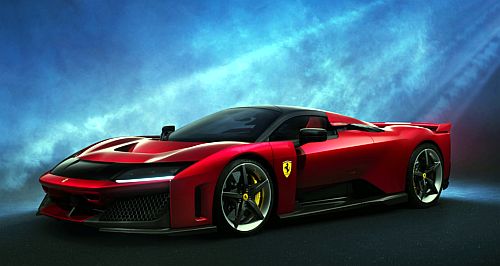New models - Ferrari - F80$7m Ferrari F80 sells outFerrari’s latest F80 hypercar finds 799 buyers before launch – for a cool $7m each21 Oct 2024 By NEIL DOWLING THE world’s most profitable car-maker has confirmed a ‘limited edition’ run of its latest supercar, the F80, with an Australian price tag of around $A7 million and local delivery dates as early as late next year.
Ferrari Australasia said the model, only just officially announced by Ferrari at a function in Italy, has already sold out its 799-unit global production run, in similar fashion to McLaren’s W1 – of which just 399 will be made.
Porsche just needs to follow up with a production version of the Mission X and this decade’s hypercar holy trinity will be complete.
“The Australian and New Zealand allocation have been sold,” said Ferrari Australasia spokesman Ryan Lewis from Italy.
“The cars are all left-hand drive and buyers purchased their cars in euros, at about €2.9 million before taxes. We will start deliveries in Q4 of 2025.
“Clients can decide when, or whether, they want to bring their cars back to Australia or NZ.”
Most of the cars are ordered by Ferrari collectors who have the first right to buy new models over other prospective owners.
The attraction to own the F80 as a collectible is alluring. The F80 becomes the latest Ferrari that assures owners of unmatched potential investment returns among new automobiles, possibly eclipsing previous limited-edition models.
Among these are the Enzo (costing $1.24m new in 2010); F40 ($600,000 in 1989); and F50 ($708,000 new in 1995) which have 2023 resale value increases of 290 per cent, 778 per cent and 1697 per cent respectively.
Ferrari has stepped aside from its naturally aspirated V12 heritage with the F80 using technology – and a lot of components – borrowed from its 3.0-litre V6-engined 499P Le Mans racer and the latest F1 cars.
The complexity and sophistication of the V6 engine is remarkable and goes some way to reflecting the F80’s price tag and exclusivity.
Hitting a total of 882kW (1183hp) – 661kW from the engine, 221kW from the three electric motors – is achieved by features including two energy-recovery motor-generator units (turbo and KERS), and two turbochargers using electric compressors to negate lag.
Two electric motors drive the front axle, with one in the rear, and thanks to lightweight materials – the connecting rods are titanium and the exhaust system is Inconel – the engine is the same weight as that in the 610kW unit in the 296.
The drive motors are made by Ferrari – the first time these components have been made in house – which opens the door to the car-maker completely supplying components for its all-electric car due next year.
Lessons learnt on the race and endurance circuits have led to the sophisticated aerodynamics including the three-plane front wing from the 499P, flat underbody, rear diffuser and active rear wing. Ferrari claims 1000kg of downforce at 250km/h.
Elements of the car’s design are borrowed from other Ferrari models but tested designers when aerodynamics and downforce factors had to be incorporated.
Ferrari said that the car was originally designed as a single-seater, later using a slightly widened cabin with a fixed passenger seat positioned slightly aft of the driver to become what it has termed a “1+” car.
The F80 also rides on active suspension and uses tyres made by Michelin specifically for this car.  Read more14th of June 2024  Ferrari rolls out 12Cilindri screamerPriced from $803,500 the appropriately named 12Cilindri celebrates Ferrari’s V12 GT heritage9th of November 2023  Ferrari hybrids outsell ICE models for first timeTimes are changing, and hybridised performance cars from Ferrari are now more popular than petrolAll new models Alfa Romeo Alfa Romeo Abarth Abarth Audi Audi Aston Martin Aston Martin BMW BMW Bentley Bentley Chrysler Chrysler Chevrolet Chevrolet Dodge Dodge Citroen Citroen Ferrari Ferrari DS DS Ford Ford Fiat Fiat FPV FPV Foton Foton Haval Haval Great Wall Great Wall Honda Honda Holden Holden Hyundai Hyundai HSV HSV Isuzu Isuzu Infiniti Infiniti Jeep Jeep Jaguar Jaguar Lamborghini Lamborghini Kia Kia Lexus Lexus Land Rover Land Rover Mazda Mazda Maserati Maserati Mercedes-Benz Mercedes-Benz McLaren McLaren Mini Mini Nissan Nissan Mitsubishi Mitsubishi Peugeot Peugeot Opel Opel Proton Proton Porsche Porsche Renault Renault Ram Ram Saab Saab Rolls-Royce Rolls-Royce Smart Smart Skoda Skoda Subaru Subaru SsangYong SsangYong Tesla Tesla Suzuki Suzuki Toyota Toyota Volvo VolvoMotor industry news |
|
















Facebook Twitter Instagram